steering wheel CHEVROLET ASTRO PASSENGER 1994 1.G User Guide
[x] Cancel search | Manufacturer: CHEVROLET, Model Year: 1994, Model line: ASTRO PASSENGER, Model: CHEVROLET ASTRO PASSENGER 1994 1.GPages: 340, PDF Size: 16.86 MB
Page 175 of 340
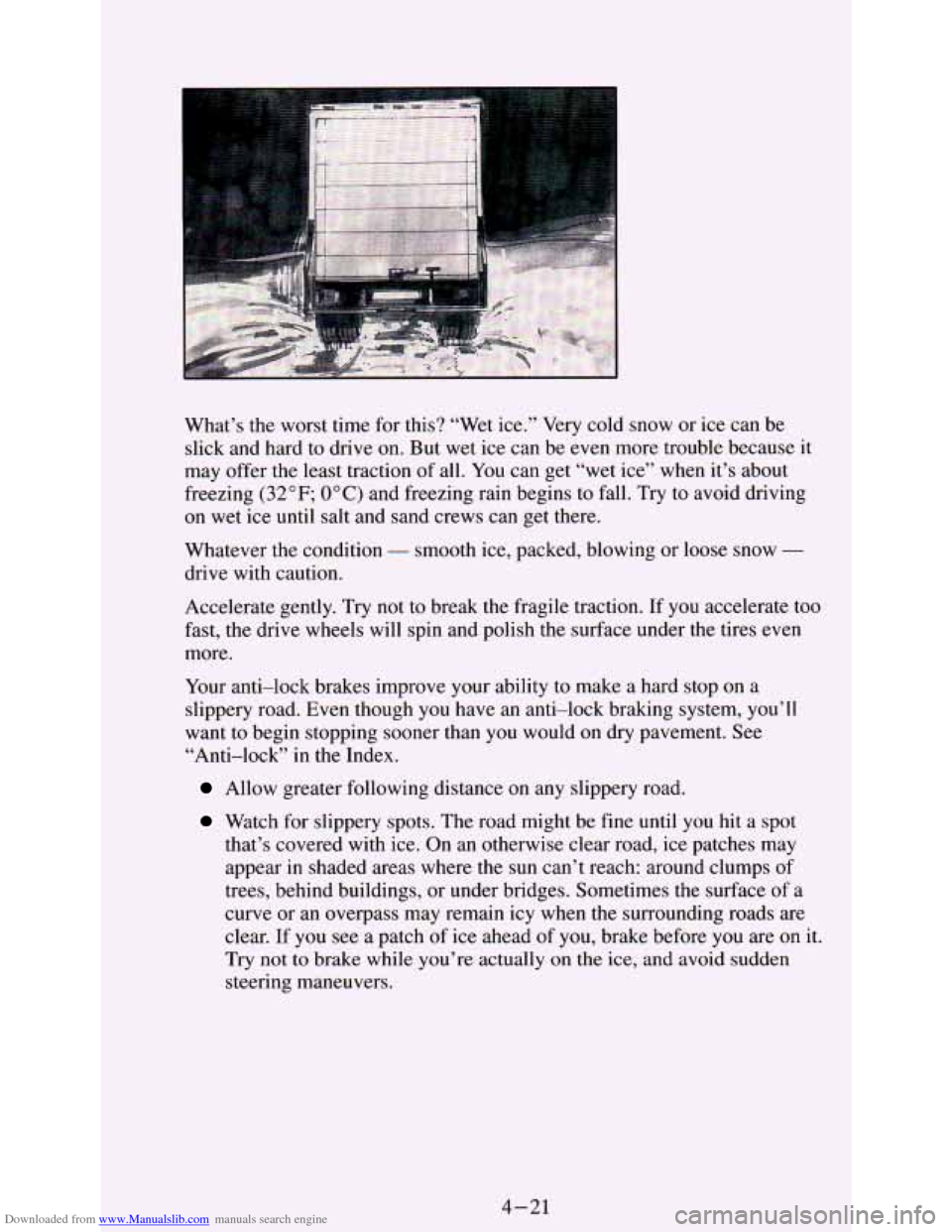
Downloaded from www.Manualslib.com manuals search engine What’s the worst time for this? “Wet ice.” Very cold snow or ice can be
slick and hard to drive on. But wet ice can be even more trouble because
it
may offer the least traction of all. You can get “wet ice” when it’s about
freezing
(32°F; 0°C) and freezing rain begins to fall. Try to avoid driving
on wet ice
until salt and sand crews can get there.
Whatever the condition
- smooth ice, packed, blowing or loose snow -
drive with caution.
Accelerate gently. Try not to break the fragile traction. If you accelerate too
fast, the drive wheels will spin and polish the surface under the tires even
more.
Your anti-lock brakes improve your ability to make a hard stop on a
slippery road. Even though you have an anti-lock braking system, you’ll
want to begin stopping sooner than you would on dry pavement. See
“Anti-lock”
in the Index.
Allow greater following distance on any slippery road.
Watch for slippery spots. The road might be fine until you hit a spot
that’s covered with ice. On an otherwise clear road, ice patches may
appear
in shaded areas where the sun can’t reach: around clumps of
trees, behind buildings, or under bridges. Sometimes the surface of a
curve or an overpass may remain icy when
the surrounding roads are
clear. If you see a patch of ice ahead
of you, brake before you are on it.
Try not to brake while you’re actually on the ice, and avoid sudden
steering maneuvers.
4-21
Page 182 of 340
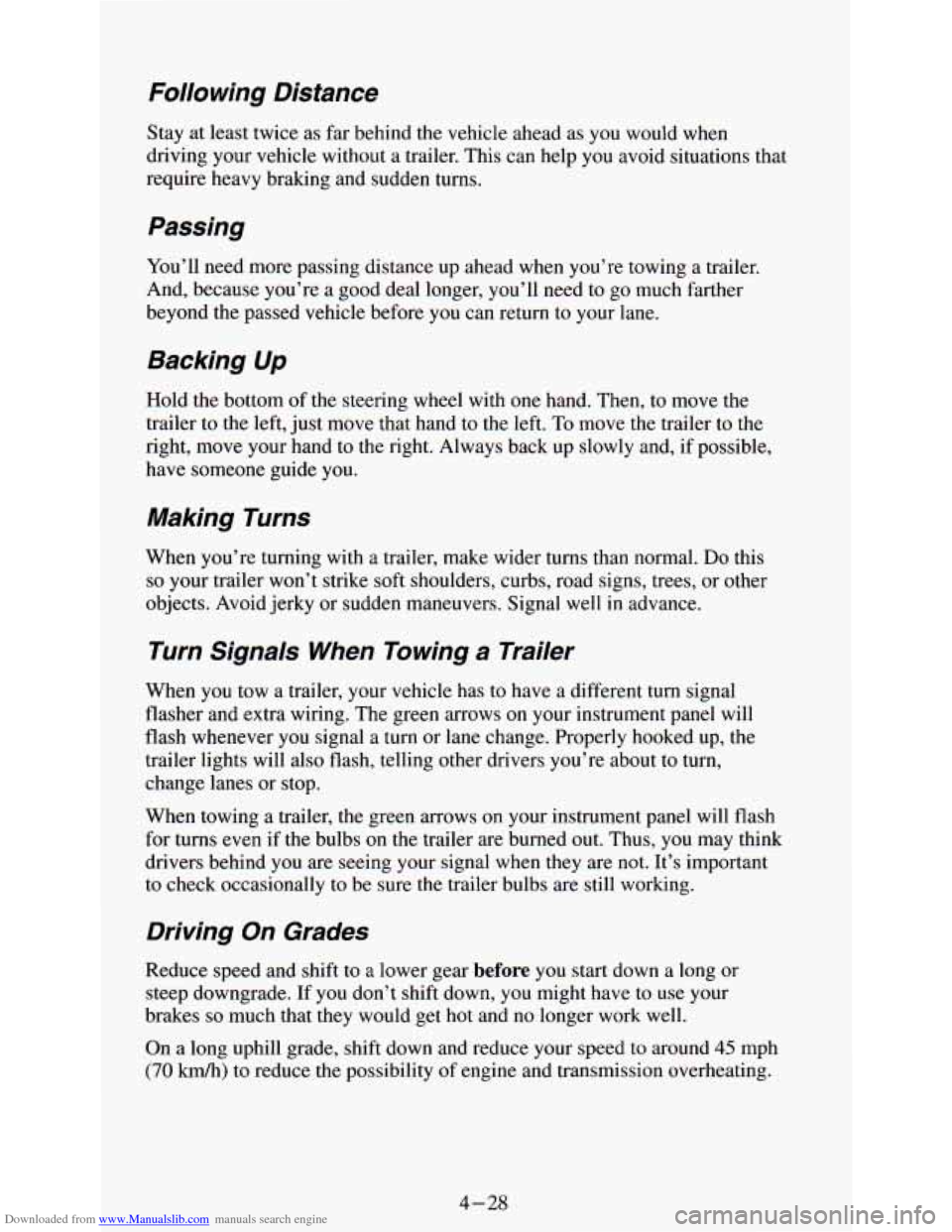
Downloaded from www.Manualslib.com manuals search engine Following Distance
Stay at least twice as far behind the vehicle ahead as you would when
driving your vehicle without a trailer. This can help you avoid situations that
require heavy braking and sudden turns.
Passing
You’ll need more passing distance up ahead when you’re towing a trailer.
And, because you’re a good deal longer, you’ll need to go much farther
beyond the passed vehicle before you can return to your lane. \
Backing Up
Hold the bottom of the steering wheel with one hand. Then, to move the
trailer to the left, just move that hand to the left.
To move the trailer to the
right, move your hand to the right. Always back up slowly and, if possible,
have someone guide you.
Making Turns
When you’re turning with a trailer, make wider turns than normal. Do this
so your trailer won’t strike soft shoulders, curbs, road signs, trees, or other
objects. Avoid jerky or sudden maneuvers. Signal well
in advance.
Turn Signals When Towing a Trailer
When you tow a trailer, your vehicle has to have a different turn signal
flasher and extra wiring. The green arrows on your instrument panel will
flash whenever you signal a turn or lane change. Properly hooked up, the
trailer lights will also flash, telling other drivers you’re about to turn,
change lanes or stop.
When towing a trailer, the green arrows on your instrument panel will flash
for turns even
if the bulbs on the trailer are burned out. Thus, you may think
drivers behind you are seeing your signal when they are not. It’s important
to check occasionally to be sure the trailer bulbs are still working.
Driving On Grades
Reduce speed and shift to a lower gear before you start down a long or
steep downgrade. If you don’t shift down, you might have to use your
brakes
so much that they would get hot and no longer work well.
On a long uphill grade, shift down and reduce your speed to around
45 mph
(70 km/h) to reduce the possibility of engine and transmission overheating.
4-28
Page 191 of 340
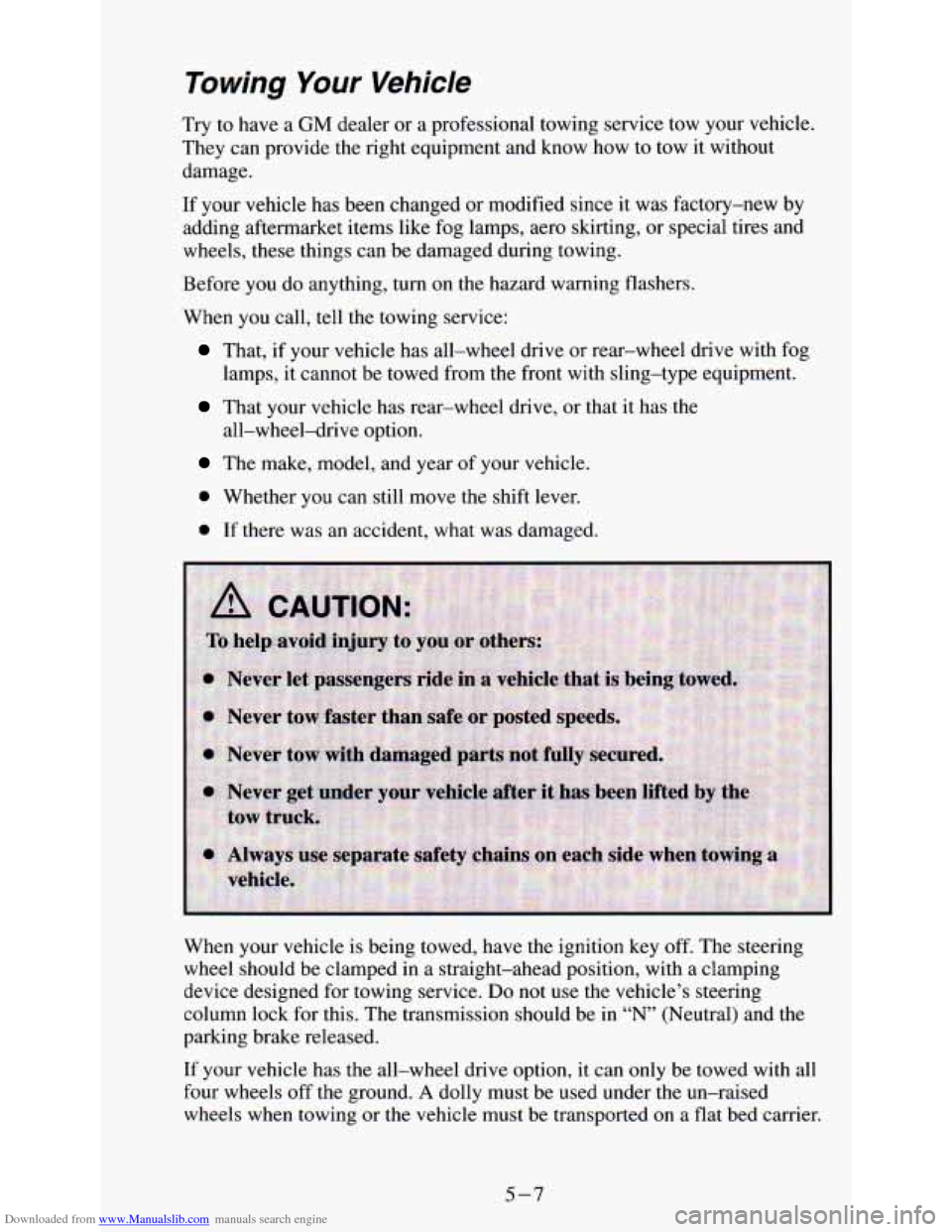
Downloaded from www.Manualslib.com manuals search engine Towing Your Vehicle
Try to have a GM dealer or a professional towing service tow your vehicle.
They can provide the right equipment and know how
to tow it without
damage.
If your vehicle has been changed or modified since it was factory-new by
adding aftermarket items like fog lamps, aero skirting, or special tires and
wheels, these things can be damaged during towing.
Before you do anything, turn on the hazard warning flashers.
When you call, tell the towing service:
That, if your vehicle has all-wheel drive or rear-wheel drive \
with fog
lamps, it cannot be towed from the front with sling-type equipment.
That your vehicle has rear-wheel drive, or that it has the
The make, model, and year of your vehicle.
all-wheel-drive
option.
0 Whether you can still move the shift lever.
0 If there was an accident, what was damaged.
When your vehicle is being towed, have the ignition key off. The steering
wheel should be clamped in a straight-ahead position, with a clamping
device designed for towing service.
Do not use the vehicle’s steering
column lock for this. The transmission should be in “N” (Neutral) and the
parking brake released.
If your vehicle has the all-wheel drive option, it can only be towed with all
four wheels off the ground.
A dolly must be used under the un-raised
wheels when towing or the vehicle must be transported
on a flat bed carrier.
5-7
Page 202 of 340
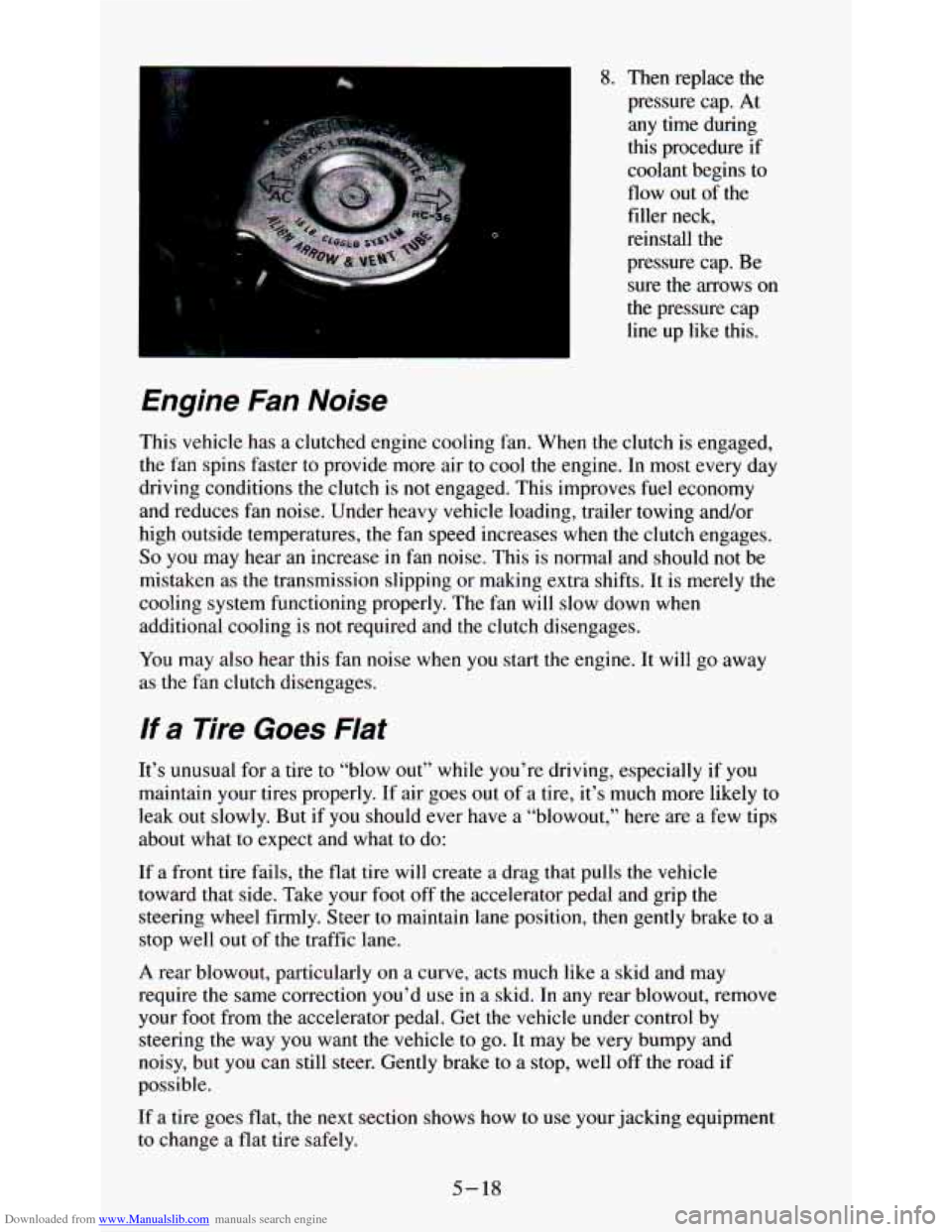
Downloaded from www.Manualslib.com manuals search engine 8. Then replace the
pressure cap. At
any time during
this procedure
if
coolant begins to
flow out of the
filler neck,
reinstall the
pressure cap. Be
sure the arrows on
the pressure cap
line up like this.
Engine Fan Noise
This vehicle has a clutched engine cooling fan. When the clutch is engaged,
the fan spins faster to provide more
air to cool the engine. In most every day
driving conditions the clutch is not engaged. This improves fuel economy
and reduces fan noise. Under heavy vehicle loading, trailer towing and/or
high outside temperatures, the fan speed increases when the clutch engages.
So you may hear an increase in fan noise. This is normal and should not be
mistaken as the transmission slipping or making extra shifts. It is merely the
cooling system functioning properly. The fan will slow down when
additional cooling is not required and the clutch disengages.
You may also hear this fan noise when you start the engine. It will go away
as the
fan clutch disengages.
If a Tire Goes Flat
It’s unusual for a tire to “blow out” while you’re driving, especially if you
maintain your tires properly.
If air goes out of a tire, it’s much more likely to
leak out slowly. But if you should ever have a “blowout,” here are a
few tips
about what to expect and what to do:
If a front tire fails, the flat tire will create a drag that pulls the vehicle
toward that side. Take your foot off the accelerator pedal and grip the
steering wheel firmly. Steer to maintain lane position, then gently brake to a
stop well out of the traffic lane.
A rear blowout, particularly on a curve, acts much like a skid and may
require the same correction you’d use
in a skid. In any rear blowout, remove
your foot from the accelerator pedal. Get the vehicle under control
by
steering the way you want the vehicle to go. It may be very bumpy and
noisy, but you can still steer. Gently brake to a stop, well off the road if
possible.
If a tire goes flat,
the next section shows how to use your jacking equipment
to change a flat tire safely.
5-18
Page 217 of 340
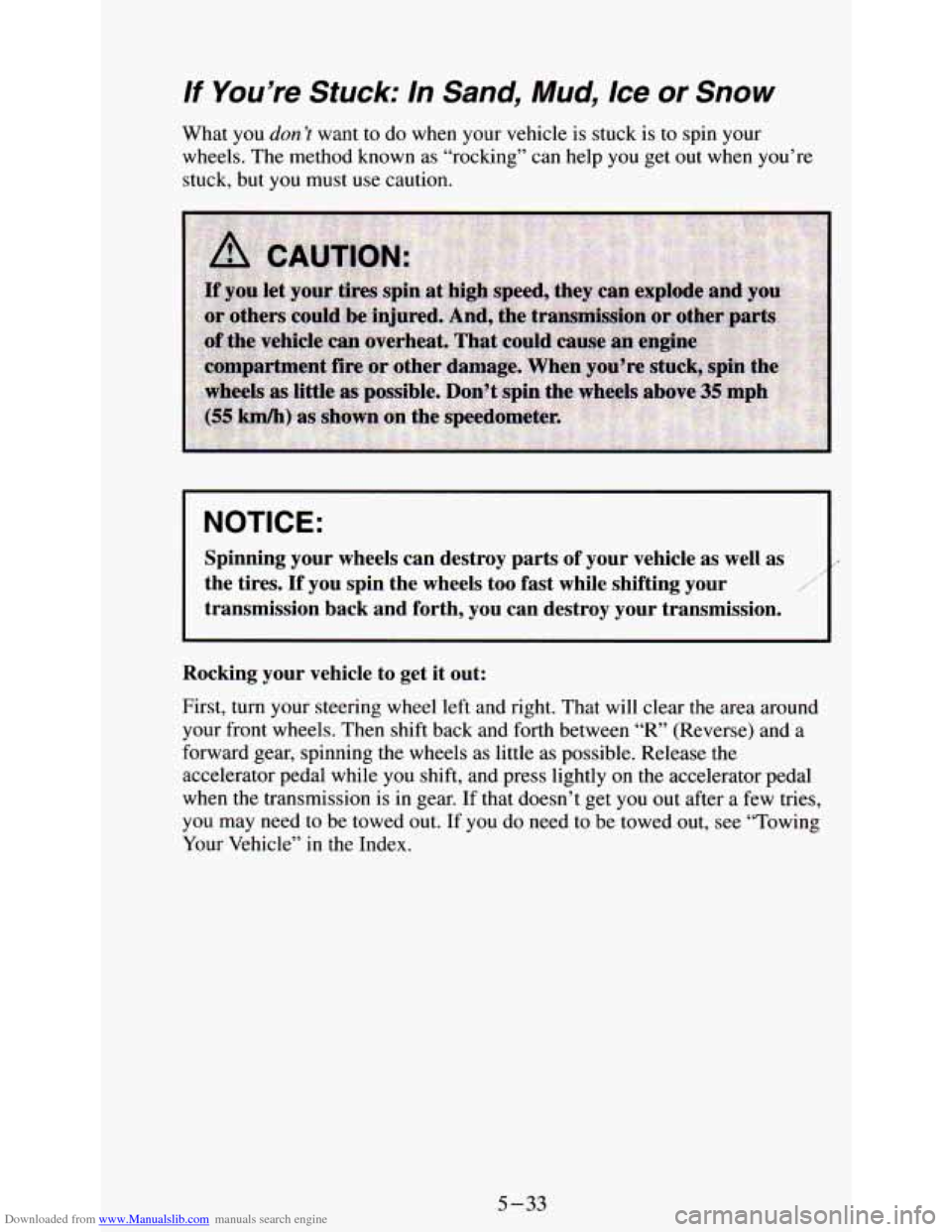
Downloaded from www.Manualslib.com manuals search engine If You’re Stuck: In Sand, Mud, Ice or Snow
What you don’t want to do when your vehicle is stuck is to spin your
wheels. The method known as “rocking” can help you get out when you’re
stuck, but you must use caution.
.. .. .. ., ..., . ....
1 NOTICE: I
Spinning your wheels can destroy parts of your vehicle as well as
the tires. If
you spin the wheels too fast while shifting your
transmission back and forth, you can destroy your transmission.
I
Rocking your vehicle to get it out:
First, turn your steering wheel left and right. That will clear the area around
your front wheels. Then shift back and forth between
“R’ (Reverse) and a
forward gear, spinning the wheels as little as possible. Release the
accelerator pedal while you shift, and press lightly on the accelerator pedal
when the transmission is in gear. If that doesn’t get you out after a few tries,
you may need to be towed out. If you do need to be towed out, see “Towing
Your Vehicle’’ in the Index.
5-33
Page 219 of 340
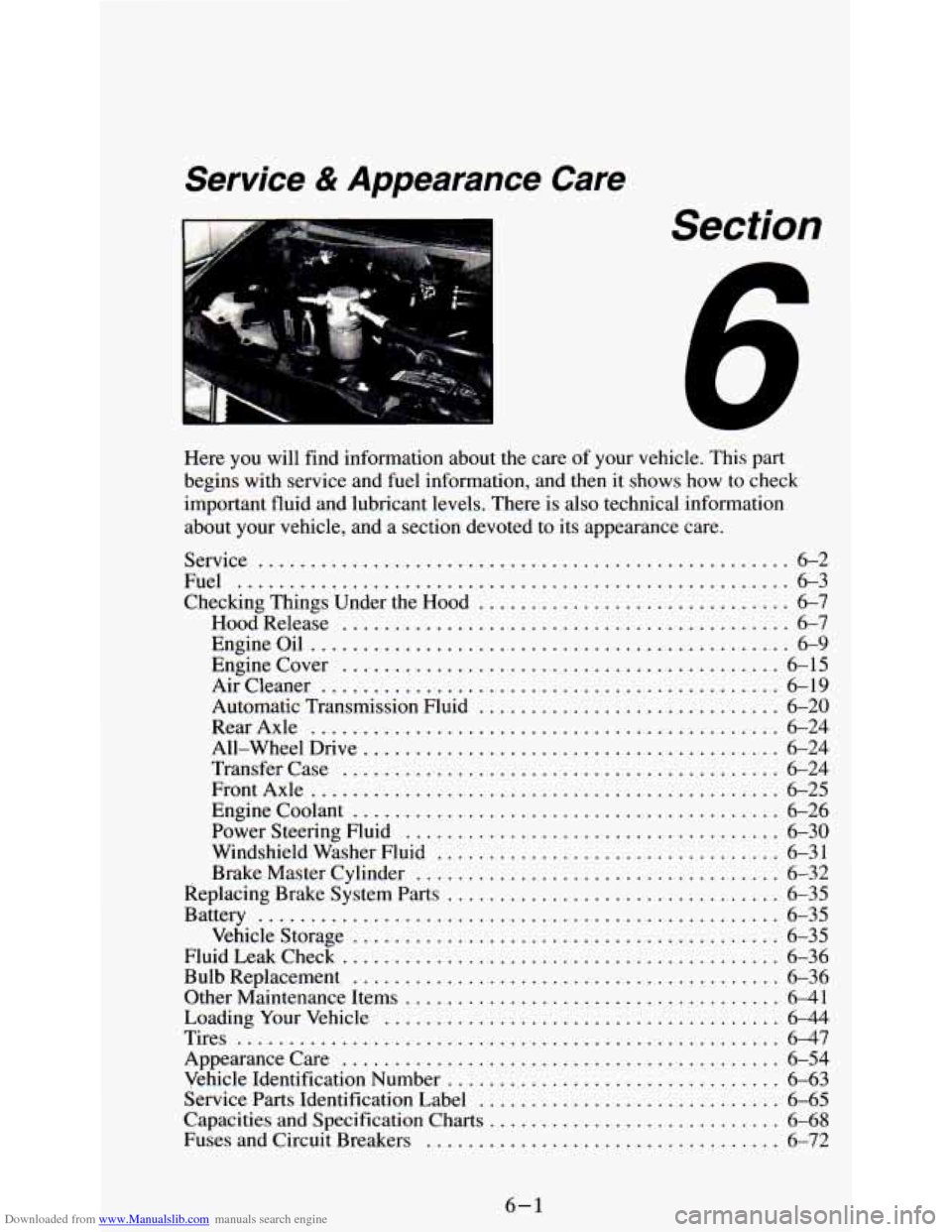
Downloaded from www.Manualslib.com manuals search engine Service & Appearance Care
...
Section
Here you will find information about the care of your vehicle . This part
begins with service and fuel information. and then it shows how to check
important fluid and lubricant levels
. There is also technical information
about your vehicle. and a section devoted to its appearance care
.
Service ................................................... 6-2
Fuel
..................................................... 6-3
Checking Things Under the Hood
.............................. 6-7
Hood Release
........................................... 6-7
Engineoil
.............................................. 6-9
Enginecover
.......................................... 6-15
Air Cleaner
............................................ 6-19
Automatic Transmission Fluid ............................. 6-20
RearAxle
............................................. 6-24
All-WheelDrive
........................................ 6-24
Transfercase
.......................................... 6-24
FrontAxle
............................................. 6-25
Engine Coolant
....................................... 6-26
Windshield Washer Fluid
................................. 6-31
Brake Master Cylinder
................................... 6-32
Replacing Brake System Parts
.................... ........ 6-35
Battery
.................................................. 6-35
Vehiclestorage
......................................... 6-35
FluidLeakCheck
.......................................... 6-36
Bulb Replacement
......................................... 6-36
Other Maintenance Items
.................................... 6-41
Tires
.................................................... 6-47
Appearancecare
.......................................... 6-54
Vehicle Identification Number
................................ 6-63
Service Parts Identification Label
..................... .... 6-65
Capacities and Specification Charts
................ . . 6-68
Fuses and Circuit Breakers ........... 6-72
Power Steering Fluid .................................. 6-30
Loading Your Vehicle
.... .............................. 6-44
6-1
Page 259 of 340
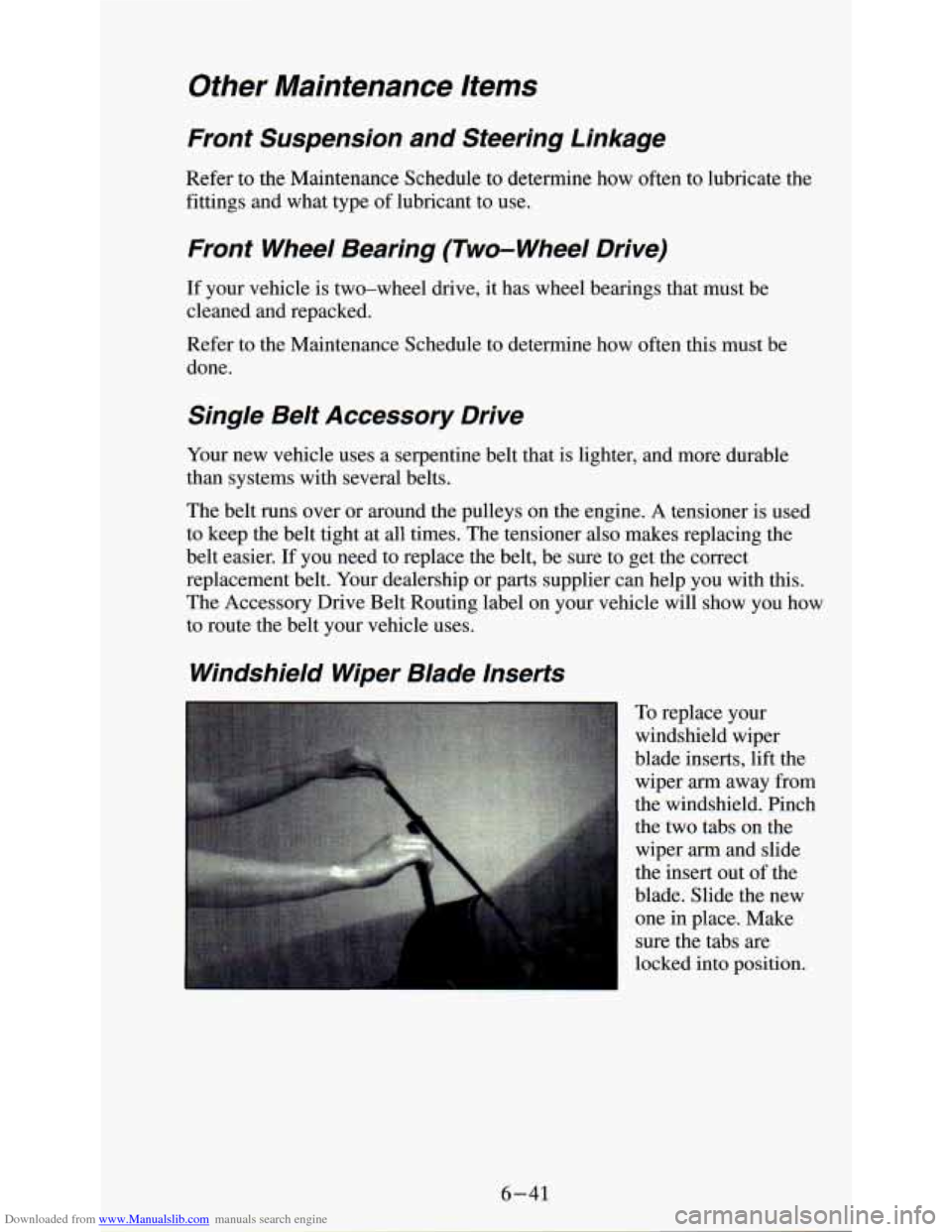
Downloaded from www.Manualslib.com manuals search engine Other Maintenance Rems
Front Suspension and Steering Linkage
Refer to the Maintenance Schedule to determine how often to lubricate the
fittings and what type of lubricant to use.
Front Wheel Bearing (Two-Wheel Drive)
If your vehicle is two-wheel drive, it has wheel bearings that must be
cleaned and repacked.
Refer to the Maintenance Schedule to determine how often this must be
done.
Single Belt Accessory Drive
Your new vehicle uses a serpentine belt that is lighter, and more durable
than systems with several belts.
The belt runs over or around the pulleys on the engine.
A tensioner is used
to keep the belt tight at all times. The tensioner also makes replacing the
belt easier. If you need to replace the belt, be sure to get the correct
replacement belt. Your dealership or parts supplier can help you with this.
The Accessory Drive Belt Routing label on your vehicle will show you how
to route the belt your vehicle uses.
Windshield Wiper Blade Inserts
To replace your
windshield wiper
blade inserts, lift the
wiper
arm away from
the windshield. Pinch
the two tabs on the
wiper
arm and slide
the insert out of the
blade. Slide the new
one in place. Make
sure the tabs are
locked into position.
6-41
Page 301 of 340
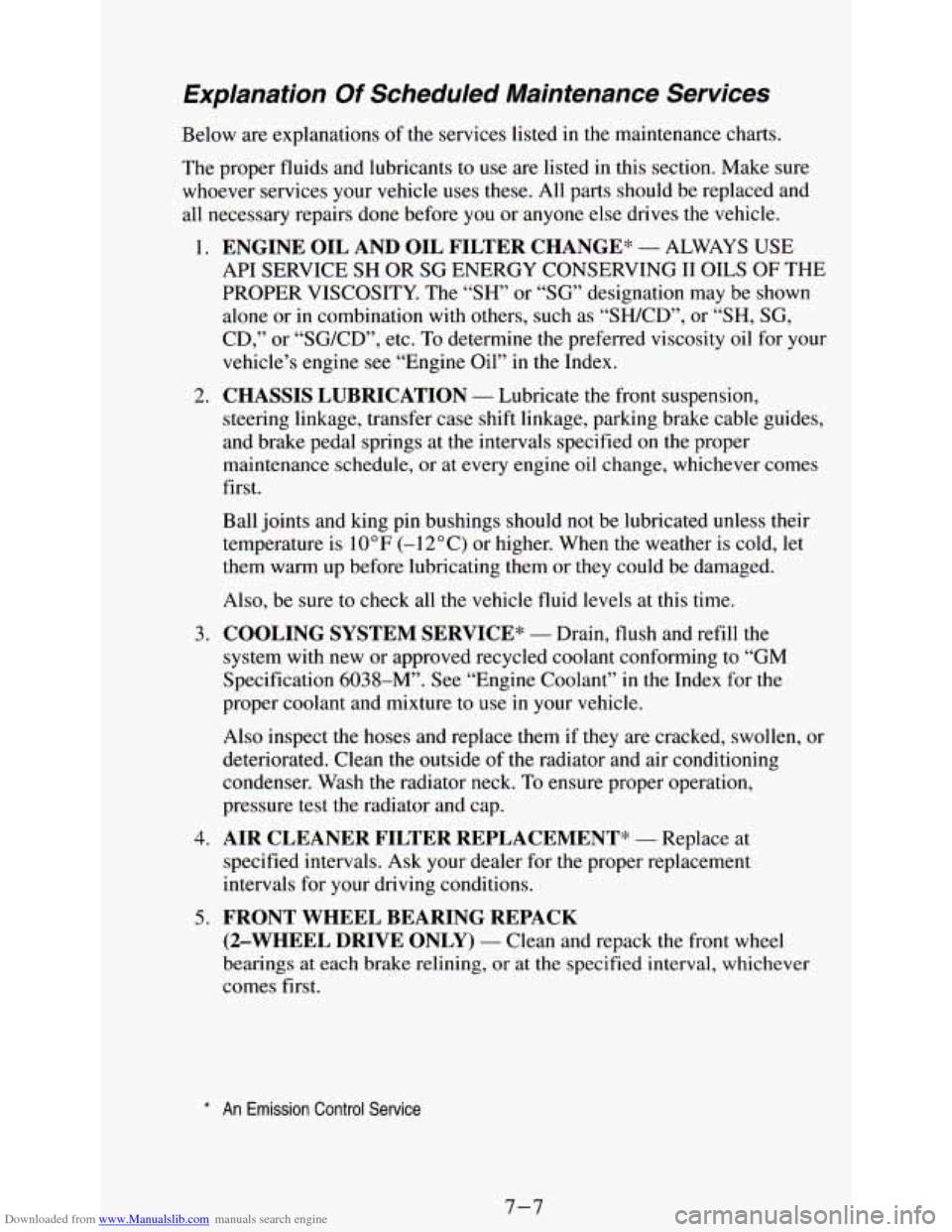
Downloaded from www.Manualslib.com manuals search engine Explanation Of Scheduled Maintenance Services
Below are explanations of the services listed in the maintenance charts.
The proper fluids and lubricants to use are listed
in this section. Make sure
whoever services your vehicle uses these. All parts should
be replaced and
all necessary repairs done before you or anyone else drives the vehicle.
1.
2.
3.
4.
5.
ENGINE OIL AND OIL FILTER CHANGE“ - ALWAYS USE
API SERVICE
SH OR SG ENERGY CONSERVING I1 OILS OF THE
PROPER VISCOSITY. The
“SH7 or “SG7 designation may be shown
alone or in combination with others, such as “SWCD”, or
“SH, SG,
CD,” or “SG/CD”, etc. To determine the preferred viscosity oil for your
vehicle’s engine see “Engine Oil”
in the Index.
CHASSIS LUBRICATION - Lubricate the front suspension,
steering linkage, transfer case shift linkage, parking brake cab\
le guides,
and brake pedal springs at the intervals specified on the proper
maintenance schedule, or at every engine oil change, whichever \
comes
first.
Ball joints and king pin bushings should not be lubricated unless their
temperature is
10°F (-1 2°C) or higher. When the weather is cold, let
them warm up before lubricating them or they could be damaged.\
Also, be sure to check all the vehicle fluid levels at this \
time.
COOLING SYSTEM SERVICE* - Drain, flush and refill the
system
with new or approved recycled coolant conforming to “GM
Specification 6038-M”. See “Engine Coolant”
in the Index for the
proper coolant and mixture to use
in your vehicle.
Also inspect the hoses and replace them
if they are cracked, swollen, or
deteriorated. Clean the outside of the radiator and air conditioning
condenser. Wash the radiator neck.
To ensure proper operation,
pressure test the radiator and cap.
AIR CLEANER FILTER REPLACEMENT* - Replace at
specified intervals. Ask your dealer for the proper replacement
intervals for your driving conditions.
FRONT WHEEL BEARING REPACK
(2-WHEEL DRIVE ONLY)
- Clean and repack the front wheel
bearings at each brake relining,
or at the specified interval, whichever
comes first.
* An Emission Control Service
7-7
Page 306 of 340
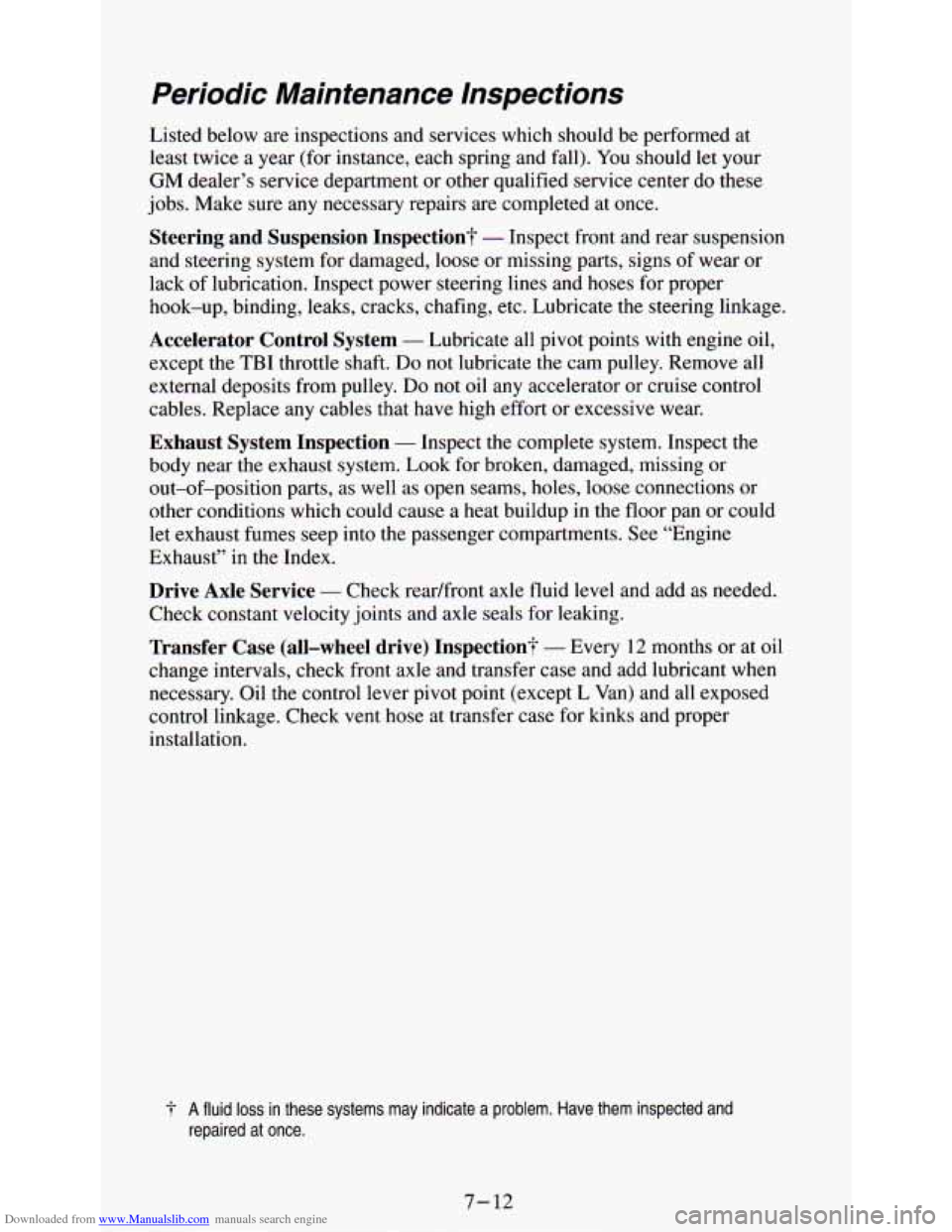
Downloaded from www.Manualslib.com manuals search engine Periodic Maintenance Inspections
Listed below are inspections and services which should be perfo\
rmed at
least twice a year (for instance, each spring and fall). You should let your
GM dealer’s service department or other qualified service center do these
jobs. Make sure any necessary repairs are completed at once.
Steering and Suspension Inspection? - Inspect front and rear suspension
and steering system for damaged, loose or missing parts, signs of wear or
lack of lubrication. Inspect power steering lines and hoses for proper
hook-up, binding, leaks, cracks, chafing, etc. Lubricate the steering linkage.
Accelerator Control System - Lubricate all pivot points with engine oil,
except the
TBI throttle shaft. Do not lubricate the cam pulley. Remove all
external deposits from pulley.
Do not oil any accelerator or cruise control
cables. Replace any cables that have high effort or excessive \
wear.
Exhaust System Inspection - Inspect the complete system. Inspect the
body near the exhaust system. Look for broken, damaged, missing or
out-of-position parts, as well as open seams, holes, loose conn\
ections or
other conditions which could cause a heat buildup
in the floor pan or could
let exhaust fumes seep into the passenger compartments. See “\
Engine
Exhaust”
in the Index.
Drive Axle Service - Check readfront axle fluid level and add as needed.
Check constant velocity joints and axle seals for leaking.
Transfer Case (all-wheel drive) Inspection? - Every 12 months or at oil
change intervals, check front axle and transfer case and add l\
ubricant when
necessary. Oil the control lever pivot point (except
L Van) and all exposed
control linkage. Check vent hose at transfer case for kinks and proper
installation.
-F A fluid loss in these systems may indicate a problem. Have them inspected a\
nd
repaired
at once.
7- 12
Page 328 of 340
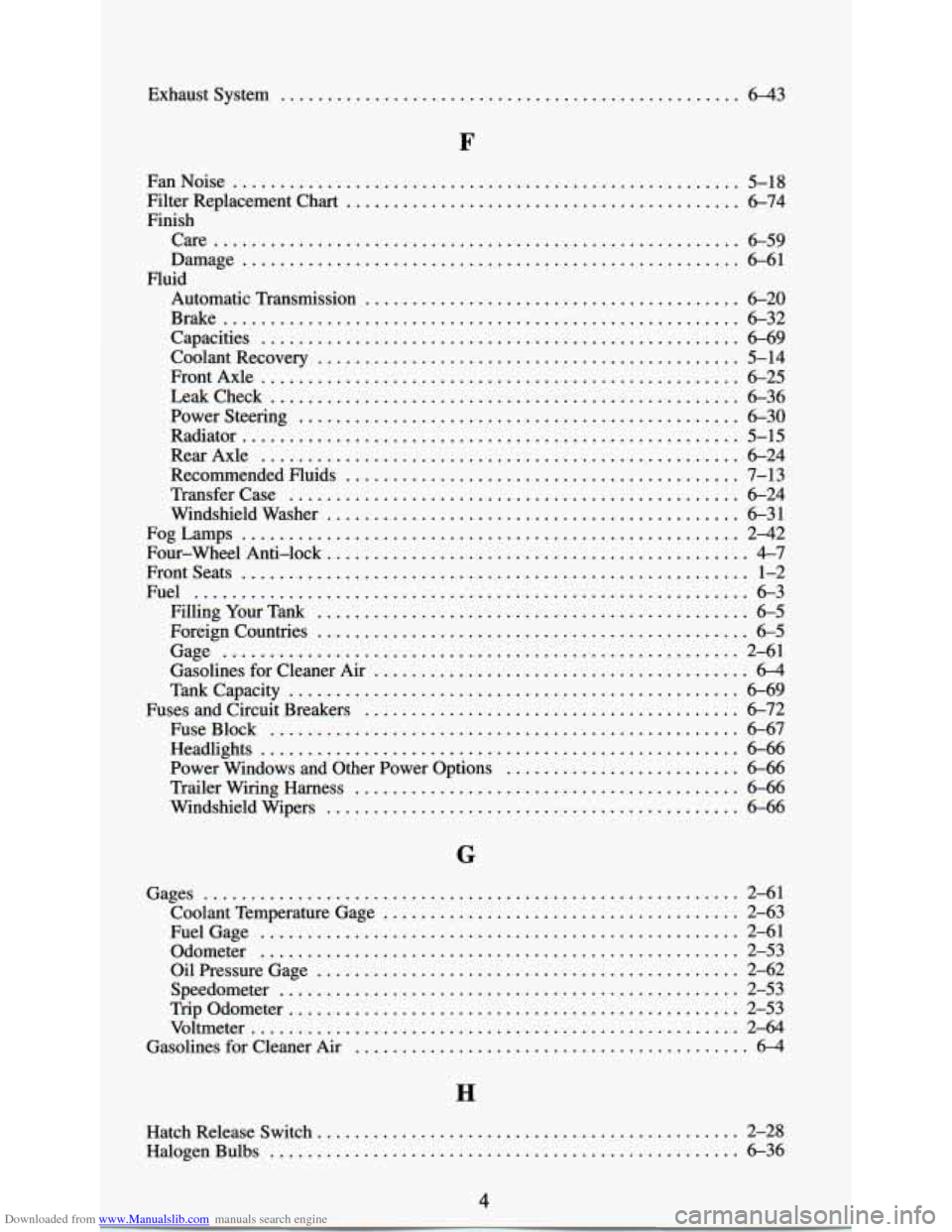
Downloaded from www.Manualslib.com manuals search engine Exhaust System ................................................. 6-43
F
FanNoise ...................................................... 5-18
Filter Replacement Chart
.......................................... 6-74
Finish
Care
........................................................ 6-59
Damage
..................................................... 6-61
Automatic Transmission
........................................ 6-20
Brake
....................................................... 6-32
Capacities
................................................... 6-69
CoolantRecovery
............................................. 5-14
FrontAxle
................................................... 6-25
Leak Check
.................................................. 6-36
Powersteering
............................................... 6-30
Radiator
..................................................... 5-15
Rear Axle
................................................... 6-24
RecommendedFluids
.......................................... 7-13
Transfercase
................................................ 6-24
Windshield Washer
............................................ 6-31
FogLamps
..................................................... 2-42
Four-wheel Anti-lock
............................................. 4-7
Frontseats
...................................................... 1-2
Fuel
........................................................... 6-3
FillingYourTank
.............................................. 6-5
Foreign Countries
.............................................. 6-5
Gage
....................................................... 2-61
Gasolines for Cleaner Air
........................................ 6-4
Tankcapacity ................................................ 6-69
Fuses and Circuit Breakers
........................................ 6-72
FuseBlock
.................................................. 6-67
Headlights
................................................... 6-66
Power Windows and Other Power Options
......................... 6-66
Trailer Wiring Harness
......................................... 6-66
Windshield Wipers
....................... .............. 6-66
Fluid
G
Gages ......................................................... 2-61
Coolant Temperature Gage
...................................... 2-63
FuelGage
................................................... 2-61
Odometer
................................................... 2-53
Oil Pressure Gage
............................................. 2-62
Speedometer
................................................. 2-53
Trip Odometer
................................................ 2-53
Voltmeter
.................................................... 2-64
Gasolines for Cleaner Air
.......................................... 6-4
Hatch Release Switch ............................................. 2-28
HalogenBulbs
........................................ ....... 6-36